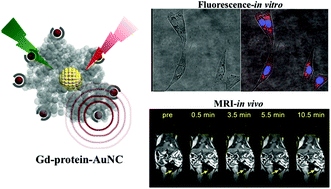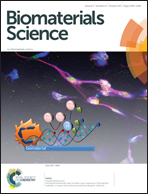Gd3+-Functionalized gold nanoclusters for fluorescence–magnetic resonance bimodal imaging†
Abstract
Multimodal imaging that aims to advance imaging by strategically combining existing technologies with uniquely designed probes has attracted great interest in recent years. In this work, Gd3+-functionalized gold nanoclusters were prepared with a straightforward and scalable approach by using proteins as templates. The impact of the synthesis approach on the conjugation efficiency of Gd chelators to proteins, as well as the fluorescence quantum yield of gold nanoclusters was carefully studied. The effect of protein size on the relaxivities of the probes was also investigated. By using the optimal conditions, dual function probes with intense red fluorescence emission and longitudinal relaxivity as high as 9.7 mM−1 s−1 could be obtained. The probes were applied for cell staining and in vivo contrast-enhanced magnetic resonance imaging (MRI). The MR images showed that the dual function probes circulated freely in the blood pool without undesirable accumulation in the liver and spleen. Meanwhile, the material could be removed from the body through renal clearance, making it attractive for practical multimodal imaging.



 Please wait while we load your content...
Please wait while we load your content...